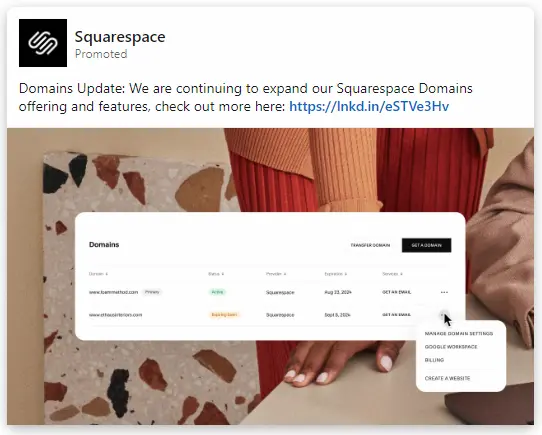
Content + Email: The Love Story You Didn’t Know You Needed
A successful marriage of content and email can maximize your marketing might. Learn how to fully leverage the combination of content and email marketing. …


Marketing has come a long way from its early days of simplistic and often intrusive strategies. Picture the old days when marketers relied on flashy, in-your-face tactics like pop-up ads and mass email blasts, hoping to catch the attention of any passerby.
Today, the landscape has transformed dramatically, favoring subtlety, precision, and personalization. Just like upgrading a classic car with the latest technology, modern marketing tactics are more sophisticated, efficient, and user-friendly.
Let’s explore the major shifts in marketing strategies and understand why these changes are crucial for thriving in today's competitive digital environment.
In the early days, brands treated social media as a one-way radio signal. They’d post content, maybe thank followers for likes, and that was it. Engagement was minimal at best.
Fast forward to today, and social media has transformed into a dynamic platform for building real, engaged communities. Brands now actively interact with their audience, responding to comments and fostering genuine conversations. It’s about creating a dialogue, not a monologue.
What brands are saying and doing on social media isn’t the only thing that has changed over the years. Previously, social media content was highly polished and meticulously curated. This was the time where if you accidentally uploaded a low-resolution photo, you better get it down and replaced before anyone important noticed.
Today’s audiences prefer authenticity. User-generated content, behind-the-scenes looks, and casual, unfiltered posts resonate more than overly produced ones. Consumers want to see the real, relatable side of brands. It’s about being genuine and building trust through transparency, not putting up a façade of unobtainable perfection.
Example:
GoPro is a fantastic example of a brand that has successfully embraced authentic, user-generated content. Their social media strategy focuses heavily on content created by their users, showcasing real-life adventures and experiences captured with GoPro cameras.

Gone are the days of mass email blasts to purchased lists consisting of mostly, if not all, cold contacts. Modern email marketing is precise and strategic. It’s about thoughtful segmentation and personalization. Automated drip campaigns triggered by subscriber actions ensure that each message is relevant and timely, enhancing engagement and driving conversions.
By leveraging user data, marketers can create tailored campaigns that resonate with specific audience segments instead of the old ways of throwing everything against a wall and hoping something sticks. This shift from generic to personalized content improves the customer experience and builds stronger, more meaningful connections. It’s quality over quantity, and it’s proving to be far more effective.
Example:
Rover, the popular online marketplace for pet care services, has mastered the art of personalized email marketing. By tailoring their emails to include pet owner names, pet names, and details of recent pet sitting bookings, Rover creates a highly engaging and personalized experience for their customers. This approach not only enhances customer loyalty but also drives repeat business and satisfaction.

Early digital advertising campaigns often focused on a single platform, hoping for the best. Today, cross-channel advertising is the key to a successful campaign. Marketers use multiple platforms – Google, Facebook, LinkedIn, Programmatic – to nurture users throughout their journey, ensuring consistent messaging and a better user experience.
Privacy has also become a significant concern. In the past, aggressive tactics were common due to minimal regulations. Today, stringent privacy laws have changed the paid advertising landscape. Marketers now prioritize first-party data and privacy-compliant strategies, adapting to a cookieless future.
Targeting has evolved, too. Beyond basic demographics, marketers now use behavioral data to refine their audience targeting. While budgets need to be larger to achieve the same results due to increased competition and algorithm changes, strategic testing with smaller budgets can still yield valuable insights.
Example:
Squarespace, a leading website building and hosting service, has established itself as a powerhouse in digital marketing through its effective multi-channel paid advertising campaigns. By strategically leveraging various platforms like Google and LinkedIn, Squarespace ensures broad reach, consistent messaging, and high engagement.

In the early days of SEO, keyword stuffing (overloading a web page with keywords and phrases in an attempt to manipulate a site's ranking in search engine results) was a common practice. Marketers would cram as many keywords as possible into their content, which often compromised readability in the process. At the time, the thought was that the more keywords, the higher the rank – simple, right?
Today, search engines are much more sophisticated and will even penalize websites for using nefarious tactics like keywords stuffing. Instead, modern SEO emphasizes high-quality, valuable content that prioritizes information and naturally incorporates keywords. It’s about enhancing the user experience by providing relevant answers to their questions, not trying to trick them into wasting their time on something they don’t need.
Example:
Before (with keyword stuffing): "Our running shoes are the best running shoes for running. Our running shoes are made with high-quality materials, making our running shoes the best running shoes you can buy. If you're looking for running shoes, our running shoes are perfect for any runner looking for running shoes."
After (without keyword stuffing): "Our running shoes are designed with high-quality materials to provide comfort and support for every runner. Whether you're a beginner or a seasoned athlete, our shoes will help you perform your best."
Pop-up ads were once ubiquitous with shopping online, aggressively vying for user attention by interrupting the browsing experience with unsolicited offers and messages. While initially effective at grabbing attention and driving clicks, their intrusive nature quickly led to widespread frustration and annoyance among users. As a result, pop-ups have largely fallen out of favor and are now rarely used as they go against modern marketing best practices.
Today, marketers favor methods like native advertising and contextual ads that blend seamlessly with the content on a page. Native ads are designed to match the look and feel of the surrounding content, providing a more organic user experience. Contextual ads, on the other hand, are placed based on the content of the webpage, ensuring that the ads are relevant to what the user is already interested in.
Respecting the user experience is paramount. Disruptive ads are out; integrated, user-friendly advertising is in. By prioritizing seamless integration and relevance, marketers can engage users in a way that feels natural and valuable, ultimately leading to higher engagement rates and improved brand loyalty.
Example:
A great example of effective native advertising can be seen with Allbirds in The New York Times. Instead of simply showing an ad, the special articles in The New York Times aim to create a rich, immersive experience for the reader, establishing an ideal platform for native advertising.
The View From Above: Why Our Future May Depend On the Fate of Birds was sponsored by Allbirds and placed within the newsfeed of The New York Times’ website as an in-feed/in-content ad. The article discusses the critical role birds play in our ecosystem and highlights the threats they face due to climate change. This topic aligns seamlessly with Allbirds' brand identity, which emphasizes sustainability and environmental responsibility, as well as a nod to the "birds" in their name.

The evolution from old-school marketing tactics to modern strategies highlights the importance of adaptation and innovation in the digital world. Today’s marketing landscape is all about engagement, personalization, privacy, and user experience. It’s a dynamic field that requires constant adaptation and innovation.
So, whether you’re a marketing pro or looking for support, remember: the only constant in marketing is change. And here at Aztek, we’re ready to help you navigate every twist and turn. Contact us today to talk about how we can support your digital marketing efforts to keep you moving forward.
